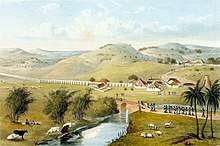Nathaniel Bayly
Nathaniel Bayly (c.1726–1798) was a West Indies plantation owner and politician who sat in the House of Commons from 1770 to 1779.

Early life
The Bayly family were plantation owners in Jamaica, but may have originated from Wesbury, Wiltshire where Nathaniel Bayly was born. After being with his family in Jamaica, he returned to England in 1759, and lived in style in London. He married Elizabeth Ingram, daughter of Hon. Charles Ingram MP on 3 May 1767. In 1769 he inherited the Jamaican property of his brother Zachary Bayly which included plantations at Baylys Vale, Brimmer Hall, Crawle, Nonsuch, Trinity, Tryal and Unity and stores and other buildings at St Mary and Port Maria Bay and Greenwich Park at St Andrew.[2] Bayly married secondly Sophia Magdalena Lamack of Clapham on 18 March 1773.[3]
Political career
Bayly was invited to stand for Abingdon in the 1768 general election, probably because he could afford the expense. He was defeated in the poll but was seated as Member of Parliament on petition on 8 February 1770. In the 1774 general election he stood for Abingdon, but fearing defeat was also named for Westbury on Lord Abingdon's interest. The election at Abingdon was declared void because the winning candidate, John Mayor, was High Sheriff at the time, and Bayly decided to sit for Westbury where he had been unopposed. Over the next few years, Bayly made frequent speeches in Parliament, almost entirely with regard to West Indies affairs. He feared mainly that the American policy would be disastrous for the Islands, but also criticized the rum contract, complained that the islands were inadequately defended and attacked an extra tax on sugar. In March 1779 he resigned his seat because he had important matters to deal with in the West Indies and could not do justice to his parliamentary duties. He had returned to England by 1783 and made several attempts to find a seat in Parliament but was unsuccessful.[3]
Later life and legacy
From 1790 to 1796, Bayly was Commissioner of Forts and Fortifications, for the North side of Jamaica. He died in Jamaica in October 1798. In his will he refers to his Sugar Plantations at Bremer Hall, Roslin, Trinity and Tryall and estates at Gibraltar and Wentworth on the island of Jamaica.[2][3]
References
- Hakewill, James. (1825) A Picturesque Tour of the Island of Jamaica, From Drawings Made in the Years 1820 and 1821. London: Hurst and Robinson & E. Lloyd. Plate 12.
- Genealogy Reports From Registers, Wills And Almanacs Descendants of Bayly
- "BAYLY, Nathaniel (c.1726-98), of Epsom, Surr. and Shipton House, Abingdon, Berks". History of Parliament Online. Retrieved 29 October 2017.
| Parliament of Great Britain | ||
|---|---|---|
| Preceded by John Morton |
Member of Parliament for Abingdon 1770–1774 |
Succeeded by John Mayor |
| Preceded by Hon. Charles Dillon Peregrine Bertie |
Member of Parliament for Westbury 1774–1779 With: Hon. Thomas Wenman |
Succeeded by Hon. Thomas Wenman Samuel Estwick |